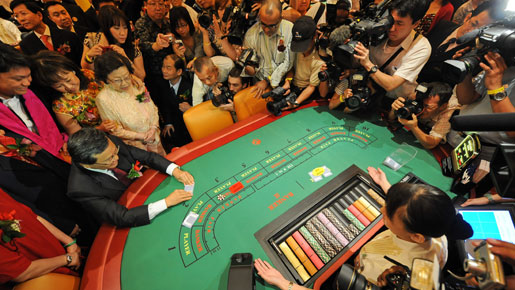
The $4.7bn Resorts World Sentosa, built by a unit of Malaysia’s Genting Group, is the first of two casinos to go into operation to transform the Southeast Asian city-state’s reputation as a manufacturing and banking hub.
Genting Group chairman Lim Kok Thay took the first bet on a game of baccarat to launch a new market for Asia’s booming casino industry and lure high-rollers away from Macau, the region’s gaming capital, as well as Malaysia and Australia.
Lim told reporters the group was actively looking at possible expansion in the US, where it could buy into existing casino resorts.
“Going forward, we are actively looking at the US because the last financial crisis has brought some pain, but at the same time we see great opportunities there, in terms of buying into existing resorts that [are] down on their luck,” he said, without identifying any targets.
Genting’s Singapore resort also houses a Universal Studios theme park, hotels and convention facilities intended to serve conservative Singapore’s aim of not only attracting gamblers, but also business executives and their families.
Visitors streaming in were greeted by a traditional lion dance. Five employees posed as Roman statues in the foyer – one carried a giant gambling chip, another a big replica of a deck of cards and a third a large red replica of a die.
“They cleared the queue very quick,” said Simon Fuller, 52, from Britain. “The revenue it will generate is good for Singapore.”
Foreigners outnumbered local residents, who have to pay an admission fee equivalent to about $70 as part of a government campaign to warn of the dangers of gambling addiction.
Restrictions
The facility on Sentosa, an island that was once a Malay graveyard and a British military base in the colonial period, formally ends longstanding opposition to gambling in a country often dubbed a “nanny state” for its squeaky clean image.
Further restrictions include a bar on entry to anyone under 21, a ban on bank cash machines on the casino floor and a blacklist of gamblers with known addiction problems.
None of that prevented Singaporean Josephine Chan from becoming the first visitor, lavished with gifts as she entered.
Fellow Singaporean Mark Lim, chafed at the admission fee.
“I don’t think it’s that fair, it’s not the best constraint,” he said. “I think Singaporeans have enough self constraint.”
Singapore hopes casinos will generate spin-offs like luxury services and increased business for private bankers in a city which many say is fast becoming Asia’s premier wealth management centre.
A second casino, Las Vegas Sands’ nearby $5.5bn Marina Bay Sands, is due to begin its phased opening in April, though many analysts doubt it can meet that target.
Singapore is already home to the highest density of millionaires in the world relative to population, and the casinos will add to the glamour generated by an annual Formula One night street race.
The question, analysts say, is whether it will attract new gamblers in Southeast Asia, a region of 600 million people.
After three recessions over the past decade – the most recent was the deepest since independence in 1965 – the government is looking for more sustainable growth as its status as a tech manufacturing base is challenged by China.
Each “integrated resort” is expected to contribute a value add of S$2.7bn ($1.9bn) to Singapore’s GDP in 2015, Singapore’s tourism promotion agency estimates, roughly between 0.5 and one percent of GDP.

